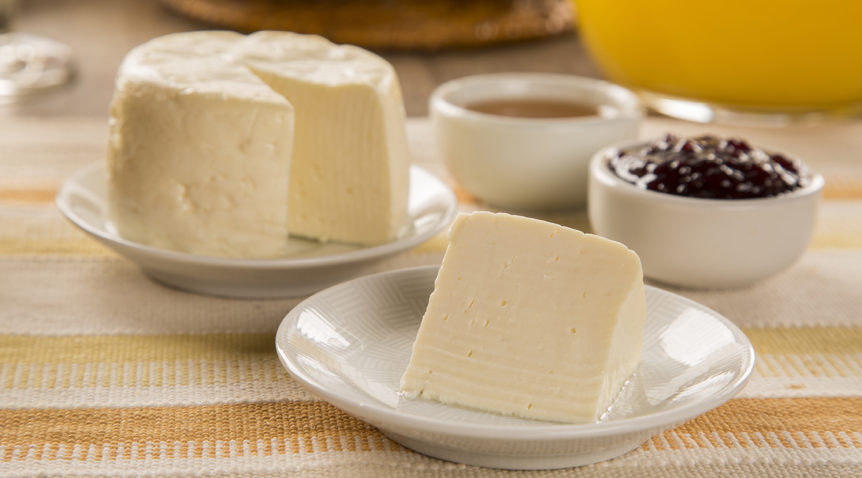When we first considered starting Winding Road Artisan Cheese, we considered several types of “rennet” for our cheeses.
I myself was a ‘dyed in the wool’ lamb rennet paste man, but my business partner wanted me to keep an open mind and suggested we take a look at this new product called Thistlezyme®, that was derived from the Cardoon Thistle. I was skeptical but agreed to give it a try. I had made cheese from Microbial rennet before (which is commonly referred to as “Vegetarian rennet”), and was not impressed with the flavor and always returned to Lamb rennet, except for my cheesemaking classes. The next question was, which cheese would we try? My business partner suggested a classic Portuguese cheese called Queijo Fresco.
Queijo fresco (literally “fresh cheese”), not to be confused with Queso Fresco, is a staple in any Portuguese table. Made with cow or goat’s milk, this white cheese is great for breakfast or as an appetizer. I had made it before using both microbial and lamb rennet. I was told that it is traditionally made using Cardoon, and given that my previous attempts were just “OK”, I figured it was worth a try. I have always heard from my Portuguese-Canadian Customers, that Queijo fresco should be firm enough to be cut, but still soft enough to be “spreadable”. With the microbial or lamb rennet, the cheese was either too firm or very moist and not very solid. Once I had searched through my various cheesemaking resources, I finally found a traditional formula that I could convert to use with Thistlezyme®. Then it was time to make cheese.
There were a few failures as I worked on dosage and temperatures. This was the first cheese that I had made that did not use some form of starter or acid to ripen the milk. It had simple ingredients: Milk, Salt, Calcium Chloride and Thistlezyme®. Sounds simple, right? This was part of my reevaluation of how I made cheese. It would become the basis of all my work with Thistlezyme® since then. After a few e-mails to one of the scientists that helped to develop the process of extracting the enzyme from the thistle, I was armed with the knowledge to continue. The only way to describe the success I had would be to describe the process and the formula.
Queijo Fresco Formula
Ingredients
• 10 Liters of Milk (Preferably non-homogenized)
• 100 grams or roughly ½ Cup of non-iodized salt
• 1.23 ml or ¼ tsp Calcium Chloride diluted in ¼ cup or 63 ml or non-chlorinated water
• 2.5 ml or ½ tsp of Thistlezyme®
Procedure
1. Sterilize all equipment
2. Add Calcium Chloride, salt, milk to your pot and stir to dissolve the salt.
3. Warm milk to 450/1130F without stirring. You want to do this with a low to medium heat to avoid scorching the milk.
4. Once you reach temperature, remove the pot from the heat source and add your Thistlezyme®, mix into the milk for at least 45 seconds and then still the milk
5. Cover the pot and allow sit for 90 to 120 minutes in a warm place.
6. Check for a clean break with the curds. If you don’t have one, wait for another 10 to 20 minutes
7. Once the curd is ready you can cut the curd into small pieces, about pea sized. Give the curd a quick, but gentle stir and allow to rest for 10 minutes.
8. Once the curd is ready you can transfer to draining baskets, cheese forms or draining bags.
a. I prefer to use a draining bag and drain the curds by laying flat on a draining rack for a few hours. This will give the curds more surface area to drain and cuts down on draining time.
9. Once the curds have drained to the point they are almost like a dry cottage cheese, it is time to form them into your final shapes. This is optional as some use it right from the draining baskets. We place the curds into molds to get a final shape so they will fit into our retail packaging.
The cheese is good for about 10 days and is best consumed within a few days of making.
So why did this cheese sell me on Thistlezyme®? I think it was because it is a fresh cheese, without any starter to mask or cover up any off flavors from the enzyme/rennet. Cardoon rennet cheeses are often bitter, but this one is not. Thistlezyme® seems to compliment the flavor of the milk as it adds a nice herbal flavor to the cheese and towards the end of the shelf life of the cheese there is a bit more pronounced “thistle” flavor, but not offputting. I also had some of my Portuguese friends try it and they were surprised at how close it was to their mother’s.
This was the encouragement I needed to try Thistlezyme® in making semi-lactic, washed rind and our firm cheeses. As I have said in a previous post, I will never go back to other forms of rennet.
***Disclosure – Ian Treuer is Co-Owner and Head Cheese Maker of Winding Road Cheese and is the only cheesemaker in Canada using CYNZIME®. He is also a Thistlezyme® Consultant with the Enzyme Development Corporation due to his work developing “Best Practices” in using Thistlezyme® in cheese making.

